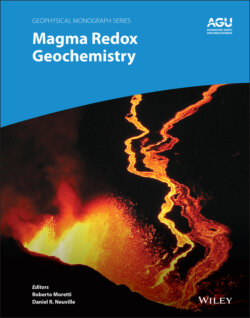Читать книгу Magma Redox Geochemistry - Группа авторов - Страница 23
2.1. THE REDOX STATE OF PLANETARY INTERIORS AND THE SPECIATION OF CARBON IN THE EARTH
ОглавлениеThe redox state of a system determines the oxidation state of multivalent elements contained therein (e.g., Fe2+ vs Fe3+) and is gauged as the partial pressure (fugacity) of oxygen (fO2). In the mantle, fO2 is buffered by the coexisting Fe‐bearing minerals mainly within peridotite rocks (Luth et al., 1990; Stagno et al., 2013). Oxygen fugacity also controls the speciation of multivalent volatiles like carbon and defines conditions under which reduced accessory minerals like carbide, graphite, and diamond can be oxidized to C4+. The consequent bonding with an O2 molecule causes lowering of the melting temperature of the locally surrounding rocks (i.e., redox melting; Taylor & Green, 1988; Stagno et al., 2013). Conversely, carbonate minerals and carbonated melts (carbonatites and kimberlites) can be reduced to elemental carbon as a consequence of the locally buffered fO2 by Fe‐bearing mineral assemblages (i.e., redox freezing; Rohrbach & Schmidt, 2011; Stagno et al., 2011; Jacob et al., 2016) that behave as an “oxygen pump” by reducing the surrounding environment. The redox state of the interior of Earth, as in other planets, is, therefore, expected to have modulated the speciation of volatile elements and set the conditions for the onset of melting of rocks at variable mantle depths to produce a large spectrum of magmas (Gudfinnsson & Presnall, 2005; Green, 2015). While some relatively cool and highly reactive small‐fraction carbonated melts may experience thermal and chemical “death” through interaction with the lithosphere (McKenzie, 1989), those that ultimately reach the surface and degas to the atmosphere set, in turn, the conditions for planetary climates and, ultimately, habitability of our planet (Williams et al., 1992; Martin et al., 2007; Gaillard et al., 2011; Brune et al., 2017; Lammer et al., 2018).
To better understand the link between the redox state of planetary interiors and volatile cycles, it is worth recalling the astronomical observation of the super‐Earth 55 Cancri e (Madhusudhan et al., 2012), the interior of which was proposed to host mostly Fe, diamonds, and SiC with no evidence of free gaseous species, based on the measurements of astronomical parameters of mass and radius used to constrain the chemistry of the interior of exoplanets (Endl et al., 2012; Gillon et al., 2012). The abundance of reduced phases obviously inhibits the formation of oxidized gaseous phases, their circulation, and exsolution at any depth in the planetary interior, and also precludes the possibility of generation and migration of volatile‐rich magmas to the surface of a planet, due to the low solubility of reduced oxygen‐free volatile species in melts, such as elemental C. In contrast, the tectonic and volcanic activity on Earth through time appears to have been coupled to the speciation of oxidized volatiles like water and CO2 both in terms of chemical composition and erupted rate of mantle‐derived magmas (Tappe et al., 2018; Fuentes et al., 2019). So, while 55 Cancri e can be considered a reduced end member among the so‐far observed planetary bodies along the carbide‐carbonate joint, Earth’s mantle represents a relatively oxidized body that records a variable redox state in its interior, allowing the stability of volatiles in different forms.
The oxidation state of planetary interiors, the volatile cycle, and, therefore, the role of carbon (and water) in the origin of magmas are all strictly linked with (i) the redox state and thermal conditions of the condensates where the planetesimals formed within the protoplanetary disks; (ii) the intrinsic oxygen fugacity (i.e., the oxygen fugacity inferred by the coexisting condensated minerals) of the building blocks; (iii) the chemical composition of the impactors during early and late accretion; and (iv) early‐planetary differentiation, in particular separation of a metallic core. These points are addressed in the following sections.
